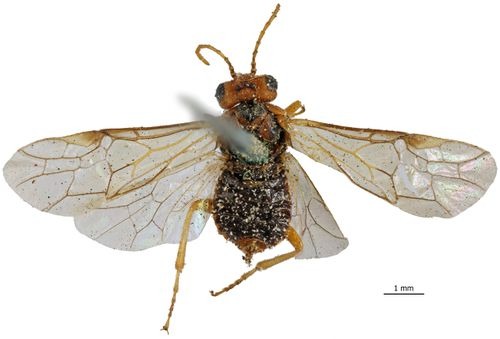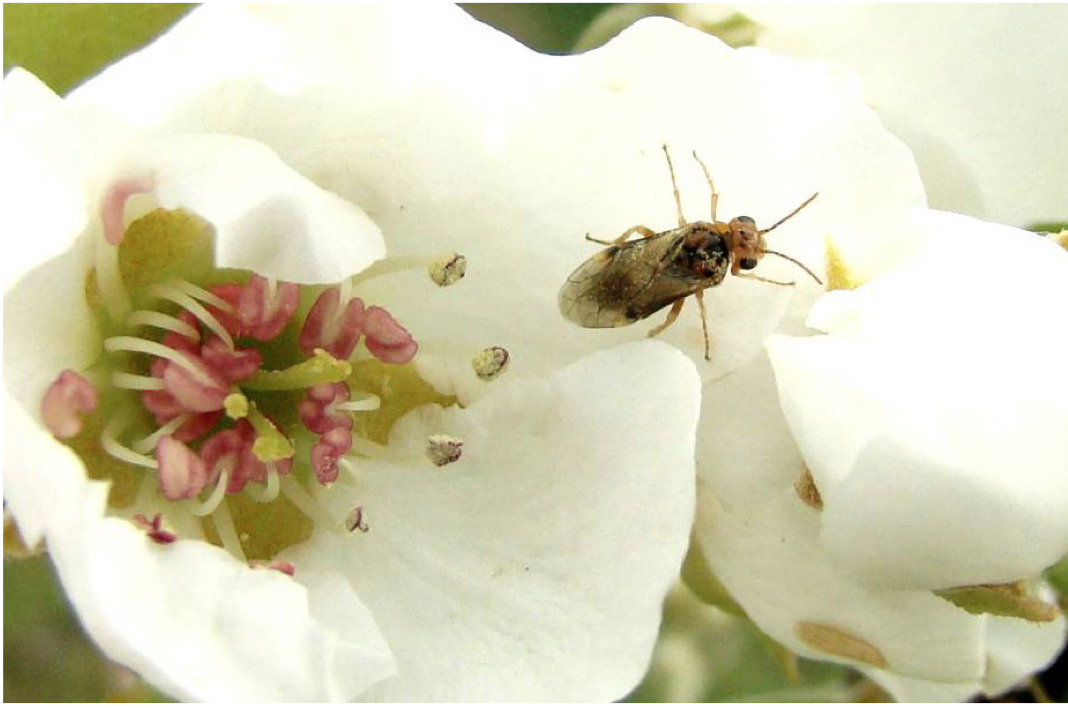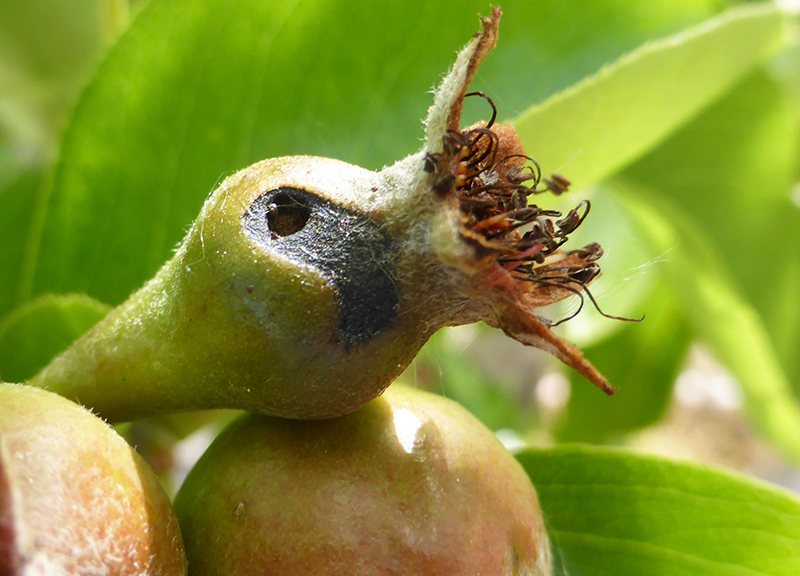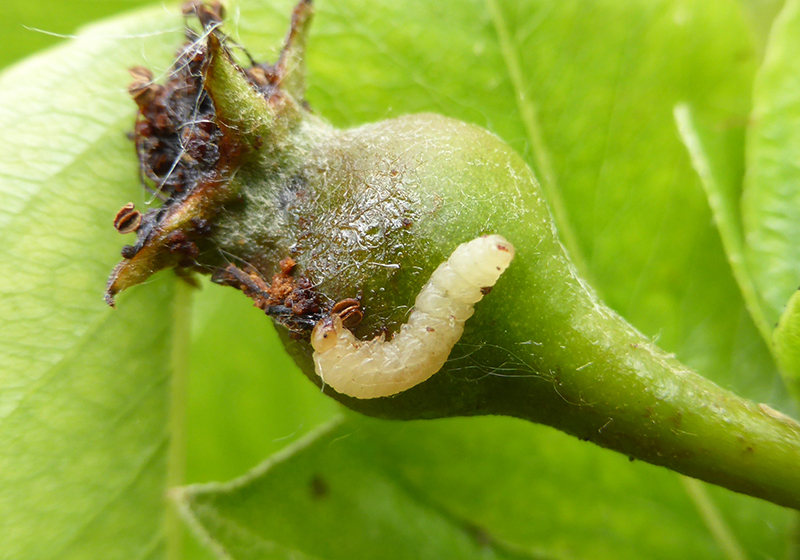
The pear fruit sawfly (Hoplocampa brevis) is a boring insect whose larvae inhabit and feed inside pear fruitlets in the early spring time. Due to the increase in prevalence north America and recent extensive crop loss at one POP orchard site, we have chosen to learn more and share what we have found about this insect. The pear fruit sawfly is not to be confused with an insect of a similar name, the pear sawfly (Caliroa cerasi), which feeds on the foliage of pear trees in the summertime. Instead, the pear fruit sawfly impacts the fruitlets of pear trees in the springtime. While the pear fruit sawfly is most commonly known to inhabit regions of the Mediterranean basin, Iran, England, Switzerland, and Austria, and Asia, the pear fruit sawfly has been documented in recent years in North America and may soon become a more prevalent pest in our region.
Our research has turned up very few resources about this newish pest. This blog is greatly indebted to Utah State University ag extension, see their article about pearfruit sawfly here.
What do we know about the pearfruit sawfly’s biology?

If you do see the insect itself, you will notice the following about the insect’s appearance: Pear fruit sawfly adults resemble flies, but they are actually small wasps that are about 3/16-inch long, and reddish-yellow in color. The larvae are also small, and are cream to yellowish-grey, with a red-brown to dark black head. When they mature, they reach 1/3-inch long.
We know that the adult population is mostly female, and they reproduce parthenogentically (without mating). In spring, females lay a single egg within the epidermis of up to 40 pear flowers. After a week or two, the larva emerges from the egg and bores itself into the pear fruitlet to feed. A single larva can enter and exit multiple fruitlets over a period of 20 to 34 days.
Once the larva reaches maturation, the larva drops to the ground, burrows into the soil, and forms a silky cocoon. The sawflies remain underground until spring, when they pupate and emerge again as adults. Approximately 25% of larvae remain in the soil an additional year. There is only one generation per year.
What are signs of an infection?

Even if you do not see the insect or larvae itself, you may suspect an infection if you notice the following on the fruitlets:
- Deformed and swollen shape in fruitlet
- Blemished skin
- Round hole near the calyx
- Black decay and wet frass
- Premature fruit drop
The impact of the pearfruit sawfly is quite serious- an infection might reduce pear yield by up to 80%, due to the premature drop of the infested fruit.
To distinguish pear fruit sawfly from codling moth, keep these factors in mind:
- symptoms of pear fruit sawfly will appear weeks before codling moth
- sawfly frass is darker in appearance and wetter in consistency
- sawfly larvae are darker in color, smaller, and have seven pairs of legs (as opposed to the coddling moth larvae’s 4).

What can we do to manage or prevent damage?
Some general practices include the following:
- Start monitoring the pear orchard for adult sawflies in March or April at three-day intervals, and continue through bloom.
- you can shake branches over white cardboard or a cloth tray to determine their presence
- After fruitlets form, inspect them for holes, oozing, and/or for frass caused by sawfly larval feeding.
- In general, the decision on whether to treat depends on the previous year’s damage, the current crop load, and the presence of adults at flowers.
- If the crop load is high, anecdotal evidence suggests that damage from pear fruit sawfly will be “absorbed” by crop thinning, and therefore, intervention may not be necessary.
What are some organic prevention measures?
If you do decide to intervene, there are a few options. While there are no products specifically labeled for this pest, pear growers have used a thorough dormant oil at the delayed-dormant stage (bud swell). Growers have also used entomopathogenic nematodes because they target the larvae in the soil. Applying a mix of nematode species Heterorhabditis bacteriophora and Steinernema carpocapsae to the soil just before larval drop (late May to early June) can reduce adult sawfly emergence the following year. Nematodes require consistent soil moisture, however, so this is only applicable to regions with consistent soil moisture.
Another prevention method is the use of white sticky tape, described in this article by the BioFruit Network and Delphy. In this method, growers use CatchIT sticky tape (Andermatt) to attract and capture sawflies and reduce the population of the pest. Because sawflies are attracted to the white color of flowers, the CatchIT sticky tape lures the insect closer and catches it with its adhesive properties. Growers are encouraged to set up the tape just prior to the spring bloom (before flowers have opened). Attach the sticky tape with staples along the horizontal trellis wires in between each tree. The only use of this prevention method has been used in orchards with trellised trees. More research needs to be done to explore ways of using white sticky tape in orchards without trellising.
Sources
Pear Fruit Sawfly (USU Extension)
Hoplocampa Brevis (Plant Pests of the Middle East)
Pear Sawfly (Hoplocampu brevis): catch that fly (BioFruit Network and Delphy)
This blog written by POP Orchard Assistant Erika D’Andrea
SUPPORT US! If you found this entry useful, informative, or inspiring, please consider a donation of any size to help POP in planting and supporting community orchards in Philadelphia: phillyorchards.org/donate.